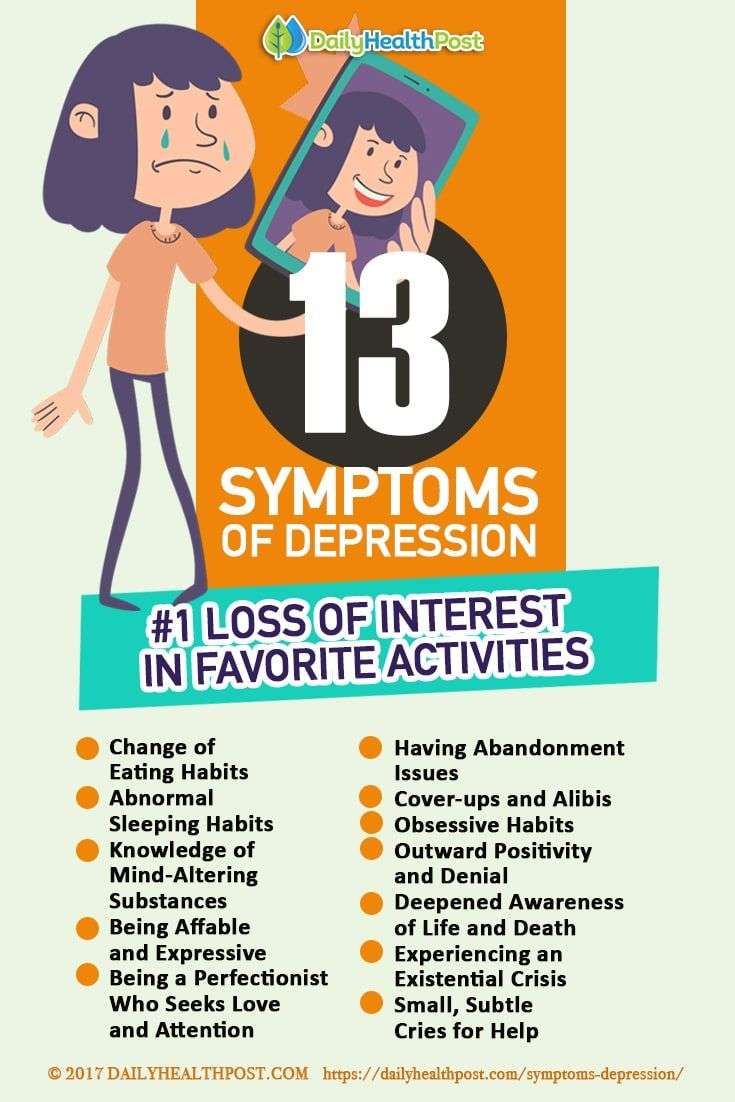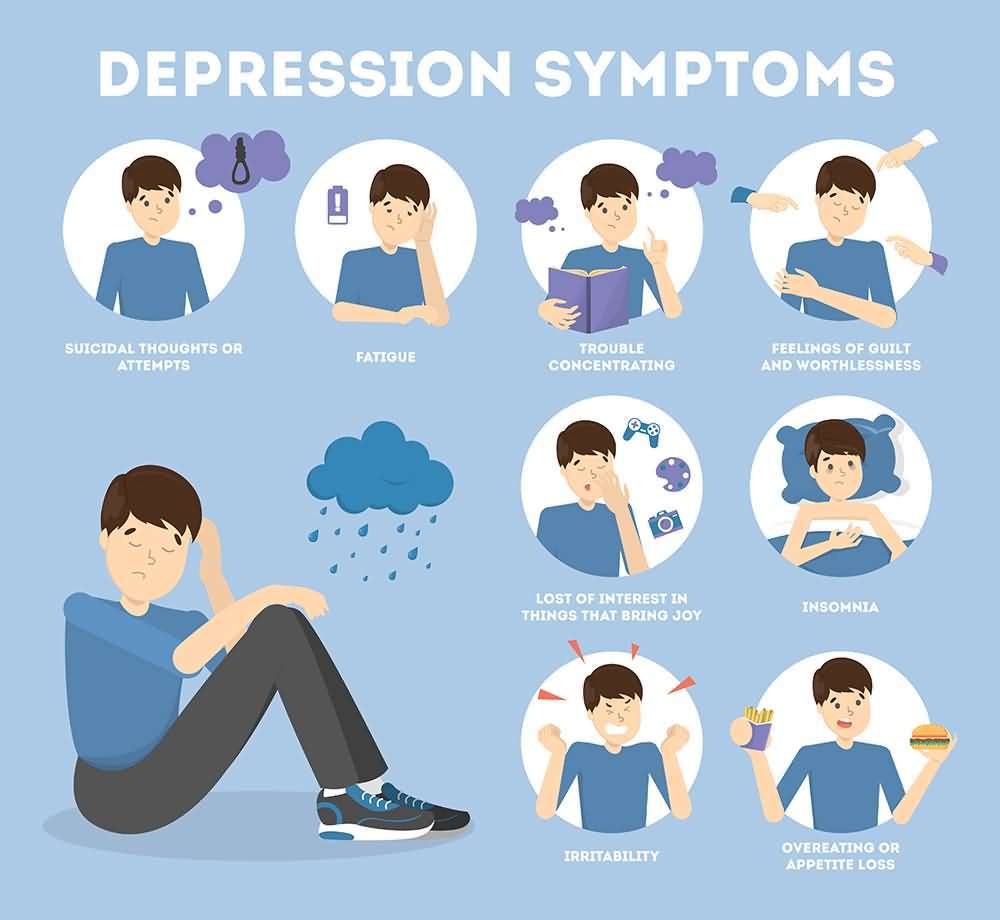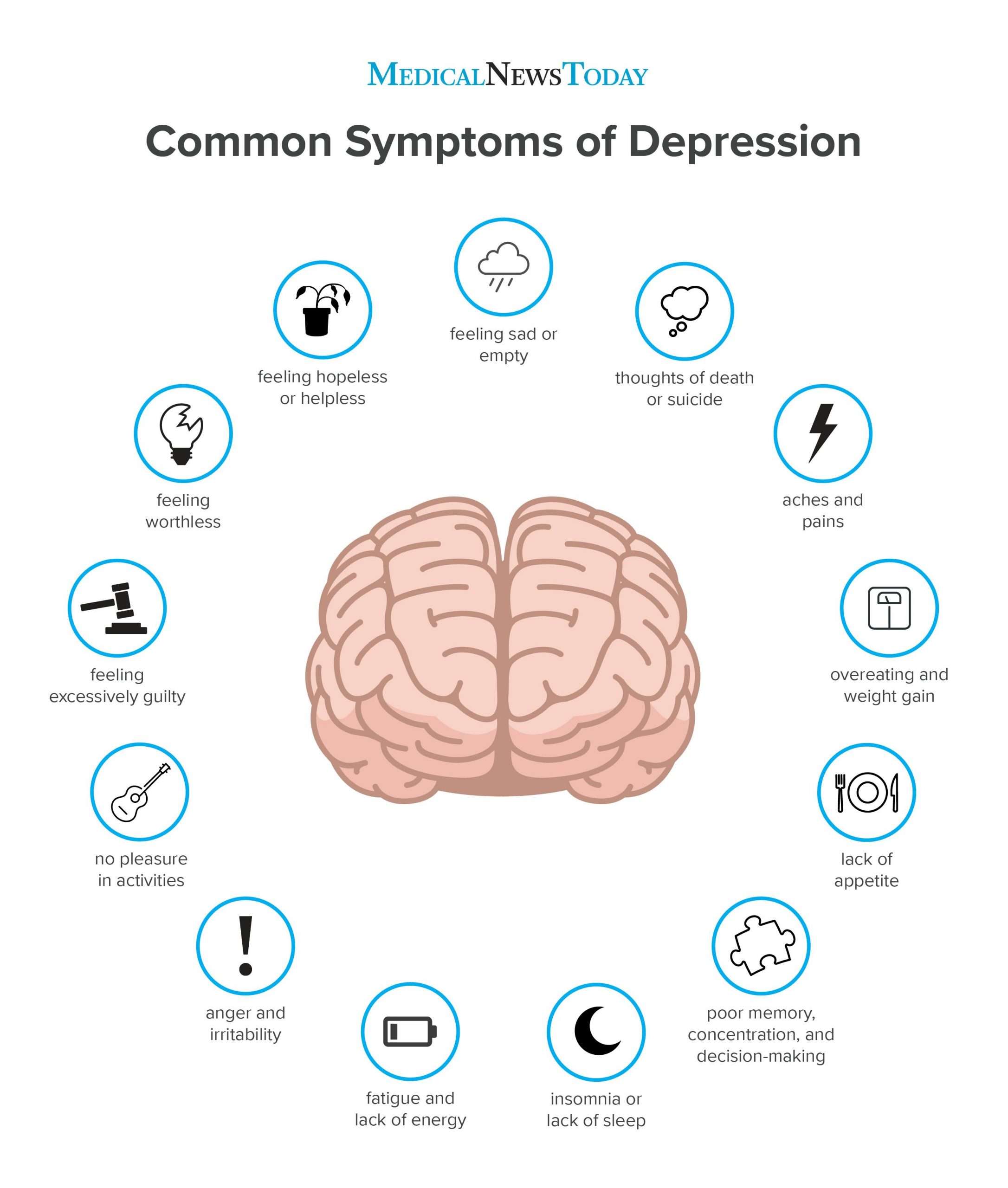How Is Depression Different From Sadness
What is the difference between depression and sadness? Given that the primary symptom associated with depression is sadness it can be hard to know how to make a distinction between the two psychological states.
But depression is more than just sadness, and not simply by a measure of degree. The difference doesnât lie in the extent to which a person feels down, but rather in a combination of factors relating to the duration of these negative feelings, other symptoms, bodily impact, and the effect upon the individualâs ability to function in daily life.
Sadness is a normal emotion that everyone will experience at some point in his or her life. Be it the loss of a job, the end of a relationship, or the death of a loved one, sadness is usually caused by a specific situation, person, or event. When it comes to depression, however, no such trigger is needed. A person suffering from depression feels sad or hopeless about everything. This person may have every reason in the world to be happy and yet they lose the ability to experience joy or pleasure.
With sadness, you might feel down in the dumps for a day or two, but youâre still able to enjoy simple things like your favorite TV show, food, or spending time with friends. This isnât the case when someone is dealing with depression. Even activities that they once enjoyed are no longer interesting or pleasurable.
New Tools For Assessing Suicide Risk
The DSM-5 does include new scales for assessing suicide risk: one for adults and one for adolescents. These scales are intended to help clinicians identify suicide risk in patients as they are developing treatment plans.
If you are having suicidal thoughts, contact the National Suicide Prevention Lifeline at 1-800-273-8255 for support and assistance from a trained counselor. If you or a loved one are in immediate danger, call 911.
For more mental health resources, see our National Helpline Database.
The tools are included in the new Section III of the DSM-5 and are intended to better support clinicians in identifying risk factors for suicide as well as scales for assessing suicidal behaviors .
New Mood Disorders Added
One major area of change in the DSM-5 was the addition of two new depressive disorders: disruptive mood dysregulation disorder and premenstrual dysphoric disorder .
The diagnosis of DMDD is reserved for children between the ages of 6 and 18 who demonstrate persistent irritability and frequent episodes of out-of-control behavior. The age of onset must be before the age of 10. The diagnosis was added to address concerns that bipolar disorder in children was being overdiagnosed.
PMDD is a more severe form of premenstrual syndrome . The conditions are characterized by intense depression, anxiety, moodiness, and irritability related to the hormonal fluctuations throughout the menstrual cycle.
PMDD previously appeared in Appendix B of the DSM-IV under “Criteria Sets and Axes Provided for Further Study.” In the DSM-5, PMDD appears in the depressive disorders section.
Recommended Reading: Helping A Partner Through Depression
Overeating And Weight Gain
Some people may eat more when they are depressed. Food can become a comfort mechanism for negative feelings or a way to deal with boredom or being alone.
Depression can make it difficult for people to feel motivated to get outside or exercise. Combined with an increase in food intake, this can lead to weight gain.
Lifestyle Changes For Depression

Changes in sleep, exercise, and diet habits can help with symptoms of depression.
Less sleep makes it harder to regulate your emotions and so may lead to depression. In fact, if you regularly have trouble getting to sleep or staying asleep , youââ¬â¢re up to 10 times more likely to have depression. And 75% of people with depression have sleep problems. Better sleep habits seem to help with depression. To sleep better:
Keep your room cool, dark, and quiet .
Go to sleep and wake up as close to the same time as possible every day.
Donââ¬â¢t drink more than 2 cups of caffeinated beverages a day and avoid caffeine in the afternoon.
Wind down before bed with at least 30 minutes of calm activities like reading, meditation, or a hot bath.
Use a journal to address thoughts and worries that might keep you up at night. Come up with a list or plan that helps you address them.
Donââ¬â¢t eat too much or too close to bed time.
Use a sleep diary to track when and how much you sleep so you can adjust.
You could worsen your depression without good nutrition and a well-balanced diet. In addition, some people have noticed an improvement of depression symptoms when they took wheat, dairy, alcohol, sugar, and caffeine out of their diets. But this is not proven to treat depression. You can try eliminating those foods one at a time from your diet and note whether your symptoms improve. It may help to keep a symptom diary.Ã
Don’t Miss: Things To Distract You From Depression
Drug Therapy For Depression
St. Johns wort St. Johns Wort The reddish substance in the plants flowers contains numerous biologically active compounds, including hypericin and hyperforin. People take St…. read more , an herbal dietary supplement, is sometimes used to relieve mild depression, although its effectiveness is not proven. Due to potentially harmful interactions between St. Johns wort and many prescription drugs, people interested in taking this herbal supplement need to discuss possible drug interactions with their doctor.
Depressive Phase Of Bipolar Disorder
Clinical depression can also be a feature of another mental health condition called bipolar disorder. People with bipolar disorder tend to alternate between periods of depression and periods of greatly elevated mood called mania.
In the depressive phase, symptoms can be very similar major depression. During the manic phase, symptoms at the opposite end of the spectrum are more likely, such as:
- Increased energy
- Impulsivity
- Poor judgment
Other forms of depression are classified a bit differently, often because they occur in specific situations or require different treatment approaches.
You May Like: Anxiety And Depression Self Assessment
What Are The Signs And Symptoms Of Depression
Common symptoms of depression include:
- Persistent sad, anxious, or empty mood
- Feelings of hopelessness or pessimism
- Feelings of irritability, frustration or restlessness
- Feelings of guilt, worthlessness, or helplessness
- Loss of interest or pleasure in hobbies or activities
- Difficulty concentrating, remembering, or making decisions
- Difficulty sleeping, early morning awakening, or oversleeping
- Changes in appetite or unplanned weight changes
- Aches or pains, headaches, cramps, or digestive problems without a clear physical cause and that do not ease even with treatment
- Suicide attempts or thoughts of death or suicide
If you or someone you know is in immediate distress or is thinking about hurting themselves, call the National Suicide Prevention Lifeline toll-free at 1-800-273-TALK . You also can text the Crisis Text Line or use the Lifeline Chat on the National Suicide Prevention Lifeline website.
What Are The Types Of Depression
Depressive disorders and mood disorders cover a range of mental health issues that cause a low mood affecting your quality of life or functioning. Depression can cause mental and emotional symptoms, but it may also cause physical symptoms like fatigue. Several types of depressive disorders have unique symptoms or experiences. The type of depressive disorder that you have can make a difference in treatment options. This is why it is important to get an accurate diagnosis.
Don’t Miss: I Want To Come Out Of Depression
Feeling Tired And A Loss Of Energy
Some people with depression may find it difficult to get up in the morning because they feel exhausted and run down.
They may feel too fatigued to do everyday tasks, such as going to work or cooking meals. They may spend a lot of time at home resting or sleeping.
The fatigue of depression can make a person feel as though they are always tired, despite getting enough sleep at night. However, others with depression do experience poor sleep.
Depression With Psychotic Features
Severe symptoms indicate psychotic depression, sometimes delusions or hallucinations where the patient sees hears, or feels things that aren’t there.
It differs from other psychotic disorders because the symptoms only occur during a depressive episode.
As you can see, all of the different depressive disorders have a unique set of symptoms that allow a healthcare practitioner or mental health professional to accurately diagnose your condition so that you can access the appropriate treatment.
You May Like: What To Do If A Friend Is Depressed
Diagnosis Of Depression In Parkinson’s Disease
Diagnosis of depression in PD is complicated by the overlap between depressive and motor symptoms. Psychomotor retardation, loss of energy, sleep problems, and poor appetite characterize both depression and PD. Starkstein and coworkers examined the validity of different subtypes of depression in a series of 173 patients with PD and found that all the DSM-IV clinical criteria for major depression and dysthymia were significantly associated with sad mood. They also reported a significant association between psychological and somatic symptoms of anxiety and sad mood, suggesting that anxiety could be added to the diagnostic criteria for major depression and dysthymia. Interestingly, motor symptoms accounted for only 11% of the variance with depression scores, suggesting that symptoms of depression in PD are not strongly influenced by the severity of parkinsonism. On the other hand, comorbid dementia had no significant impact upon the DSM-IV clinical criteria for major depression or dysthymia, suggesting that these criteria may be used in PD regardless of the presence of dementia. A taskforce commissioned by the Movement Disorders Society concluded that the Beck Depression Inventory and the Hamilton Depression Scale have been adequately validated for screening and to measure the severity of depression in PD. Nevertheless, the gold standard for establishing the diagnosis of depression remains a structured interview and standardized criteria such as in the DSM-IV or the ICD-10.
What Causes Mood Disorders

Mood disorders have no single cause, but several risk factors interact to produce the clinical symptoms of the various mood disorders. Individuals with depression and bipolar disorder often find a history of these disorders among immediate family members.Footnote 3 ,Footnote 4 Many different genes may act together and in combination with other factors to cause a mood disorder. Research is getting closer to identifying the specific genes that contribute to depression.
Recommended Reading: Can A Traumatic Event Cause Depression
Transcranial Direct Current Stimulation
Transcranial direct current stimulation is another noninvasive method used to stimulate small regions of the brain with the help of a weak electric current. Increasing evidence has been gathered for its efficiency as a depression treatment. A meta-analysis was published in 2020 summarising results across nine studies concluded that active tDCS was significantly superior to sham for response , remission and depression improvement. According to a 2016 meta analysis, 34% of people treated with tDCS showed at least 50% symptom reduction compared to 19% sham-treated across 6 randomised controlled trials.
What Does The Doctor Look For To Make A Depression Diagnosis
A doctor can rule out other conditions that may cause depression with a physical examination, a personal interview, and lab tests. The doctor will also do a complete diagnostic evaluation, discussing any family history of depression or other mental illness.
Your doctor will evaluate your symptoms, including how long you’ve had them, when they started, and how they were treated. Theyâll ask about the way you feel, including whether you have any symptoms of depression such as:
- Sadness or depressed mood most of the day or almost every day
- Loss of enjoyment in things that were once pleasurable
- Major change in weight or appetite
- Insomnia or excessive sleep almost every day
- Physical restlessness or sense of being run-down that others can notice
- Fatigue or loss of energy almost every day
- Feelings of hopelessness or worthlessness or excessive guilt almost every day
- Problems with concentration or making decisions almost every day
- Recurring thoughts of death or suicide, suicide plan, or suicide attempt
You May Like: Does Depression Come In Cycles
What Are The Complications Of Depression
When depression becomes very severe, dark thoughts can emerge and these can even lead to suicide. If you are having thoughts of suicide, talking to someone you trust can help.
If someone you care about has severe depression, learn the warning signs, since they may be feeling so bad that they cant see their way out alone.
Formal Symptoms Of Depression
According to the Diagnostic and Statistical Manual of Mental Disorders, 5th edition, text revision , major depressive disorder or clinical depression refers to the presence of five or more of the following symptoms:
These symptoms must be present during a 2-week period or longer, with at least one of the symptoms being low mood or loss of interest or pleasure.
You May Like: Major Depressive Disorder Generalized Anxiety Disorder
How Is Depression Syndrome Diagnosed
Everyone may feel sad or down from time to time. However, clinical depression has more intense symptoms that last two weeks or longer.
To determine whether you have clinical depression, your healthcare provider will ask questions. You may complete a questionnaire and provide a family history. Your healthcare provider may also perform an exam or order lab tests to see if you have another medical condition.
What Are The Symptoms Of Major Depressive Disorder
Your doctor or a mental health professional can diagnose major depressive disorder based on your symptoms, feelings, and behaviors.
Typically, youll be asked specific questions or given a questionnaire so health professionals can better determine whether you have MDD or another condition.
To be diagnosed with MDD, you need to meet the symptom criteria listed in the Diagnostic and Statistical Manual of Mental Disorders, 5th edition . This manual helps medical professionals diagnose mental health conditions.
According to its criteria:
- you must experience a change in your previous functioning
- symptoms must occur for a period of 2 or more weeks
- at least one symptom is either depressed mood or loss of interest or pleasure
You must also experience 5 or more of the following symptoms in the 2-week period:
- You feel sad or irritable most of the day, nearly every day.
- Youre less interested in most activities you once enjoyed.
- You suddenly lose or gain weight or have a change in appetite.
- You have trouble falling asleep or want to sleep more than usual.
- You experience feelings of restlessness.
- You feel unusually tired and have a lack of energy.
- You feel worthless or guilty, often about things that wouldnt usually make you feel that way.
- You have difficulty concentrating, thinking, or making decisions.
- You think about harming yourself or suicide.
Symptoms parents should be aware of in their teens include the following:
Recommended Reading: How Can You Tell You Have Depression
What Are The Dsm
The specific DSM-5 criteria for major depressive disorder are outlined below.
At least 5 of the following symptoms have to have been present during the same 2-week period :
-
Depressed mood: For children and adolescents, this can also be an irritable mood
-
Diminished interest or loss of pleasure in almost all activities
-
Significant weight change or appetite disturbance: For children, this can be failure to achieve expected weight gain
-
Sleep disturbance
-
Psychomotor agitation or retardation
-
Fatigue or loss of energy
-
Feelings of worthlessness
-
Diminished ability to think or concentrate indecisiveness
-
Recurrent thoughts of death, recurrent suicidal ideation without a specific plan, or a suicide attempt or specific plan for committing suicide
The symptoms cause significant distress or impairment in social, occupational or other important areas of functioning.
The symptoms are not attributable to the physiological effects of a substance or another medical condition.
The disturbance is not better explained by a persistent schizoaffective disorder, schizophrenia, delusional disorder, or other specified or unspecified schizophrenia spectrum and other psychotic disorders
There has never been a manic episode or a hypomanic episode
New Specifiers For Depression

The DSM-5 added new specifiers to further clarify depression diagnoses when applicable: with mixed features and with anxious distress.
- With mixed features: This new specifier allows for the presence of manic symptoms within a diagnosis of depression for patients who do not meet the full criteria for a hypomanic or manic episode .
- With anxious distress: This specifier was added to account for the presence of anxiety, tension, or restlessness with the potential to impact prognosis and treatment choices.
Read Also: How Long For Depression To Go Away
How Can My Healthcare Provider Tell Whether I Am Sad Or Depressed
Throughout life, people face many situations that result in feelings of sadness or grief: death of a loved one, loss of a job, or the ending of a relationship. Your healthcare provider, during your appointment, will likely have an unstructured conversation with you to figure out whether you might be clinically depressed or whether you are struggling with a temporary sadness that is not depression.
While depression shares some characteristics with grief and sadness, they are not the same. Typically, people experiencing grief will feel overwhelming sad feelings in waves, according to the American Psychiatric Association. In the case of grief, self-esteem is usually maintained.
With Major Depressive Disorder , the painful emotions tend to persist without much relief and often are paired with feelings of worthlessness and self-loathing. The National Institutes of Health writes that Major Depressive Disorder causes severe symptoms that affect how you feel, think, and handle daily activities, such as sleeping, eating, or working. These symptoms must be present for at least two weeks in order to be diagnosed with depression.